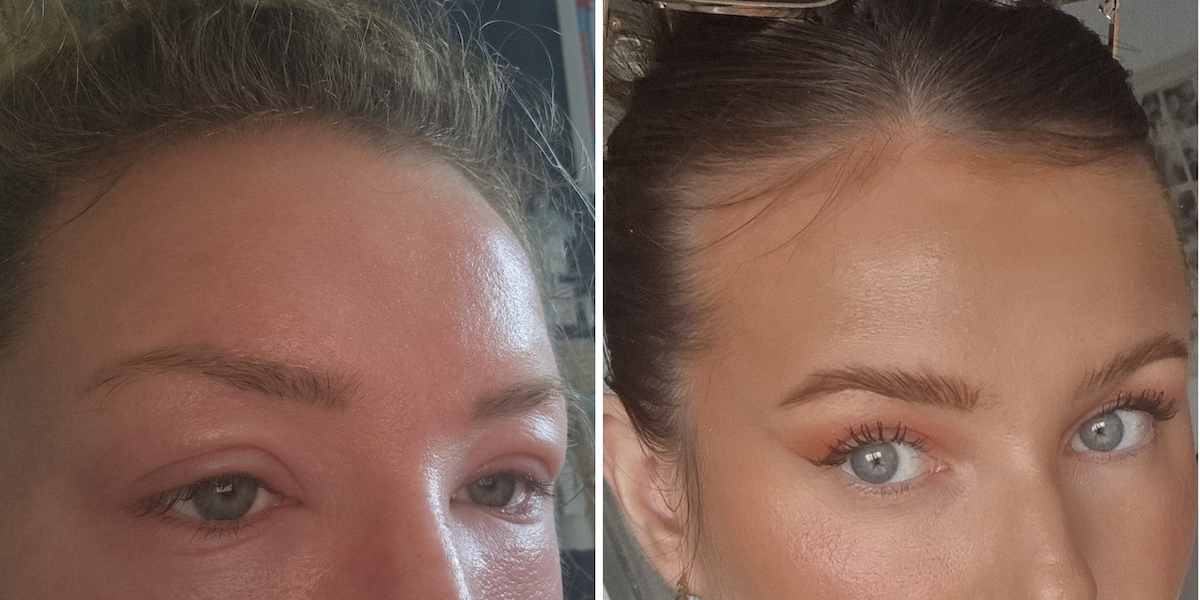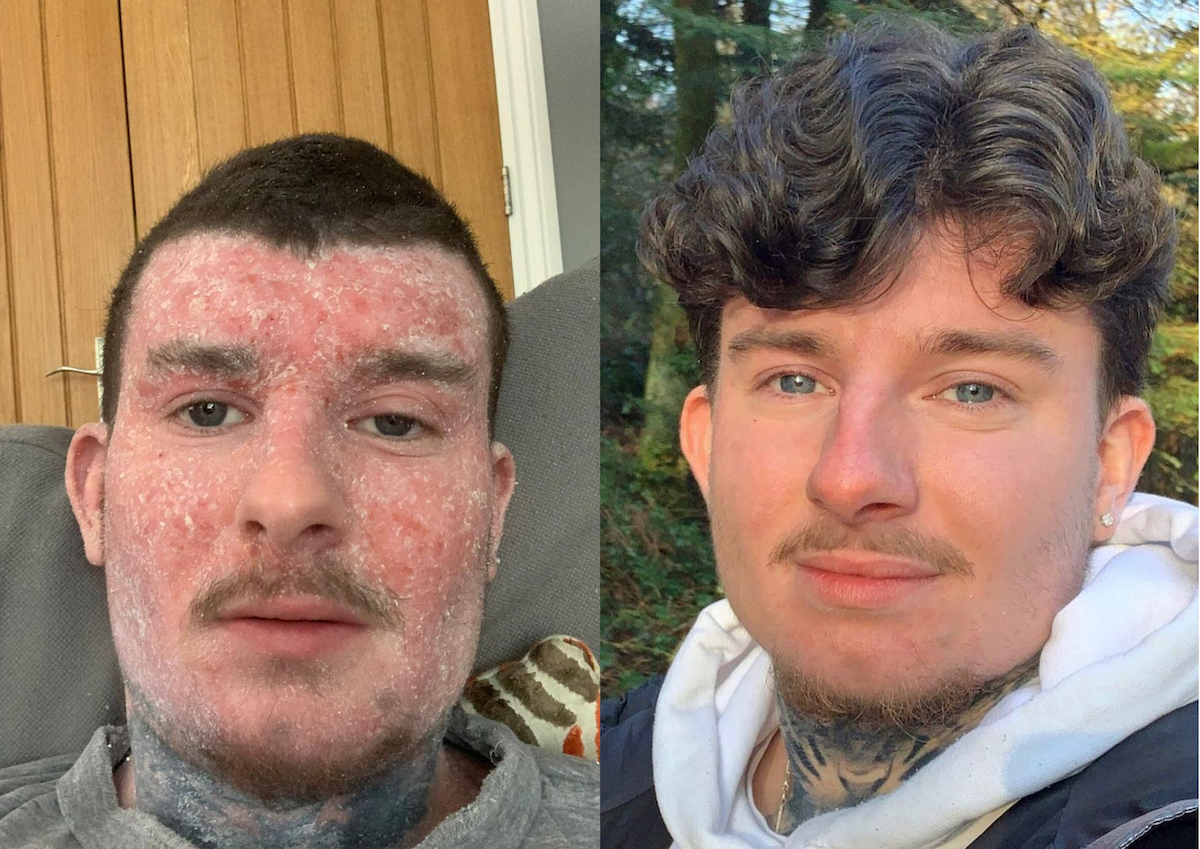Lauren Bell (30) developed mild eczema as a child but says she grew out of it until having a flare-up when she went off to university to study product development.
“I think it was just down to student lifestyle,” she says. “And the regular student stresses like doing a dissertation that triggered it.”
She started using a corticosteroid creams and after a couple of years she noticed the small patch she had on her wrist and neck was starting to spread all up her arms and to her chest as well as to her face, particularly around the eyes.
Thinking that more steroid cream was the answer, like many patients assume (or are advised by their doctor) she upped her usage.
While researching for a solution for the unbearable itching, and as part of her final-year project, she learned about topical steroid withdrawal (TSW) and realised that it could be the cream given to her by her GP that was making her eczema worse.
“My brother has eczema too and it’s way more severe than mine so we decided as a family to stop using it,” says Bell.
The decision led to her skin becoming paper thin, oozing, swollen and painful thanks to intense burning, stinging and itching.
What is topical steroid withdrawal?
“Topical steroid withdrawal (TSW) refers to the symptoms which occur when a patient reduces or ceases use of topical steroids,” explains Westlabs Bath Salts founder, Penny Hamilton.
“The underlying condition is no longer just the original skin condition, but the body is now also suffering withdrawal symptoms due to becoming reliant on the topical corticosteroids.”
Common withdrawal side-effects include burning, swelling, itching, flaking and oozing of the skin, but other symptoms can include nerve pain, altered thermoregulation, atrophy and hair loss.
Withdrawal is often accompanied by painful skin redness, which resembles patches or sleeves of sunburn. This is why TSW can also be referred to as “red skin syndrome” (RSS).
Lauren during a TSW flare-up and her fully recovered
What is eczema?
Sometimes referred to as "a worldwide epidemic", atopic dermatitis, or eczema as it’s more commonly known, is a prevalent, complex and persistent inflammatory skin disorder impacted by myriad factors. It often follows a cycle marked by intermittent worsening and periods of remission.
“Derived from the Greek word meaning ‘to boil’, its trademark symptoms include recurring instances of redness, inflammation and pruritus,” explains Cigdem Kemal Yilmaz, founder of CPD-accredited skincare education platform Skin Masterclass.
In the UK up to 20% of school-age children and one in 12 adults suffer from it, representing a huge need for care and solutions.
“Manifestations are often conspicuous, presenting as dry, flaky patches that induce profound itching and may progress to swelling and oozing due to persistent scratching,” continues Yilmaz.
“The exact aetiology of eczema remains elusive, but it’s thought to stem from a combination of genetic predisposition and an exaggerated immune reaction to diverse environmental stimuli like allergens, irritants, and micro-organisms.”
Sufferers of eczema often end up going to their GP for help to relieve the itching and subsequent raw and wounded skin. They are usually put on topical corticosteroids with little regard for the root cause of the condition.
The problem with current eczema care
Topical steroids and corticosteroids are medicines applied directly to the skin to treat conditions such as eczema or psoriasis.
They have multiple mechanisms of action but primarily they block the chemical reactions that cause inflammation.
They also change how immune cells work by reducing the amount of toxins they release naturally when fighting infection or viruses and constrict capillaries thus reducing localised pain and swelling.
This all sounds great for someone suffering from the symptoms of eczema, but the problem is, the skin can become incredibly dependent on, or even “addicted” to, these medications, causing the skin to react badly when its use is stopped. This is called topical steroid withdrawal (TSW).
Are topical steroids safe?
If used correctly for short periods at a time, such as one week, topical corticosteroids shouldn’t cause any serious side effects, says Hamilton.
However, “the majority of GPs and patients are completely unaware of the risks of incorrect steroid use and of TSW as a condition”, she adds.
In 2021, the Medicine Health and Regulation Agency (MHRA) published a statement on the long-term continual use of topical steroids linked to skin withdrawal side effects.
It called for all health professionals to prescribe the lowest potency of topical corticosteroid needed to effectively treat conditions such as eczema and psoriasis, reduce usage amount and time in long-term users, educate patients and report adverse reactions.
“But, while the MHRA have been in acknowledgement of TSW since 2021, there’s still a lack of evidence-based research or definitive NHS guidelines for GPs for how to prevent or diagnose topical steroid addiction and withdrawal,” continues Hamilton.
“GPs and dermatologists are stuck between a rock and a hard place. Their first-line treatment for managing skin conditions is now being challenged by their patients. Yet, supporting steroid avoidance would mean going against the current NHS and international guidelines. With such limited awareness or research into TSW, there are no definitive guidelines for them to work within to best support their patients’ needs.”
She adds, “As many medical professionals are unaware of TSW or the symptoms of increased tolerance to corticosteroids, this can lead to misdiagnosis.
“It can be assumed that the symptoms of steroid addiction are the original medical condition worsening, resulting in higher doses and an escalating potency being incorrectly prescribed.
“Over time this can result in even stronger steroids no longer proving effective, and by this time, the patient has become fully addicted to topical corticosteroids.”
@cosi_care I have wise old hands 🥲 can you guess where I used steroid creams for years?! #TSW #steroiduse ♬ original sound - K
The impact of TSW
TSW patients and parents can often feel unsupported and desperate – not knowing how to manage their symptoms effectively and safely.
“They feel forced to ‘go it alone’ with their TSW, which means they’re not receiving the medical care needed to keep them safe, comfortable and prevent dangerous skin infections,” says Hamilton.
“As there’s still no formal recognition for the thousands of patients suffering the unbearable effects of TSW, they’re having to turn to online communities for help and support. The TSW community are losing their trust in their doctors, feeling that their voices aren’t heard.
She adds, “They see TSW as a preventable and avoidable life-changing condition which isn’t being recognised by the medical profession.”
“It's hell!,” says Bell. “Not only are you in 24/7 physical pain, you don't feel like you look good so you don't want to leave the house and even having a shower is painful. It has this huge knock-on effect on your entire life.”
Bell says that despite going through the withdrawal badly for a few months, even spending some time in hospital with extreme swelling, she affirms that it was nothing compared to what her brother has gone through.
Lauren's brother Rhys during the peak of a TSW flare-up (left) and recovered (right)
“He was bed-bound for three months. He didn't leave the house for six months. His skin just wasn’t functioning like skin should.
“He couldn't shower because it would burn, when he walked his skin would crack… he was like a burns victim.
“You can imagine what that does to a young man – unable to date or hang with friends. He was completely crippled by it.”
Another effect of steroid use and TSW can leave sufferers with is skin that appears severely aged.
“The main place I had eczema was my hands and my wrists so that's where I used steroid creams, says Bell. “My face looked 30 and my hands looked 90,” she says.
Making matters worse she also developed an allergy to acrylic nails.
To raise awareness, one day last year she decided to post a TikTok video with her hands up to her face, which went viral around the world.
“I did it because a lot of people on social media didn’t believe they were my hands. After, so many people started sharing their hands aged by corticosteroids and their stories or saying that they had always wondered why their hands looked so old and never realised that it was down to the creams.”
Hamilton warns that “dealing with this ongoing traumatic and unsupported condition can unsurprisingly lead to depression, insomnia, anxiety, and even PTSD and suicidal thoughts”.
She adds, “The withdrawal process usually lasts for years, and isn’t linear. Meaning that the patient experiences many setbacks both physically and emotionally.”
What can skin and aesthetics professionals do to help TSW sufferers?
Despite TSW being largely misunderstood by GPs, your client should consult theirs before or after making changes to their treatment plans.
“Given the heightened sensitivity and reactivity of eczema-prone skin, a comprehensive knowledge of a client’s medical history including any past eczema flares, is essential prior to initiating any clinic-based treatments,” says Yilmaz.
As well as topical corticosteroids, the management of eczema predominantly revolves around the application of emollient moisturisers but the implementation of these warrants thorough deliberation and collaboration with your client’s GP.
Hypochlorous acid has shown potential as a non-steroidal alternative for managing certain occurrences of eczema due to its antimicrobial and anti-inflammatory properties, Yilmaz points out.
But, it’s important to note that while it can offer these benefits, it may not fully replace the role of topical steroids in all cases.
“Light therapies (red light particularly is effective for managing eczema), alongside topical products that have hypoallergenic and fragrance-free formulas, with barrier-repairing ingredients such as ceramides, hyaluronic acid, glycerin and colloidal oatmeal, are considered effective,” she adds.
Hamilton has seen great results for eczema and TSW with dead sea salts containing magnesium, to help soothe and nourish dry, itchy skin while helping to protect and repair the skin’s natural barrier.
“Many people going through TSW use Dead Sea baths as a regular part of their healing journey to provide some comfort and relief,” she says.
Westlabs is in the process of launching new Skin Repair Salts, which are a blend of Dead Sea salt and colloidal oatmeal.
“These were developed for my son, as they are incredible at soothing eczema flares which can prevent the need for topical corticosteroids,” she says.
For Bell’s aforementioned research project, she invented Cosi-Care, which has gone on to become a medically certified device brand to enable safe scratching for children and adults with itchy skin conditions.
The products aim to break the itch-scratch cycle of inflammation and infection with cooling stainless steel rollers and corrugated star-shaped tools.
Her viral videos have shone a light on the impact of TSW, the huge unmet need and the necessity for more research.
“It’s easy to feel very alone with this condition so it’s important to raise awareness to give people hope and help them find solutions for their skin,” she explains.





square.JPG)